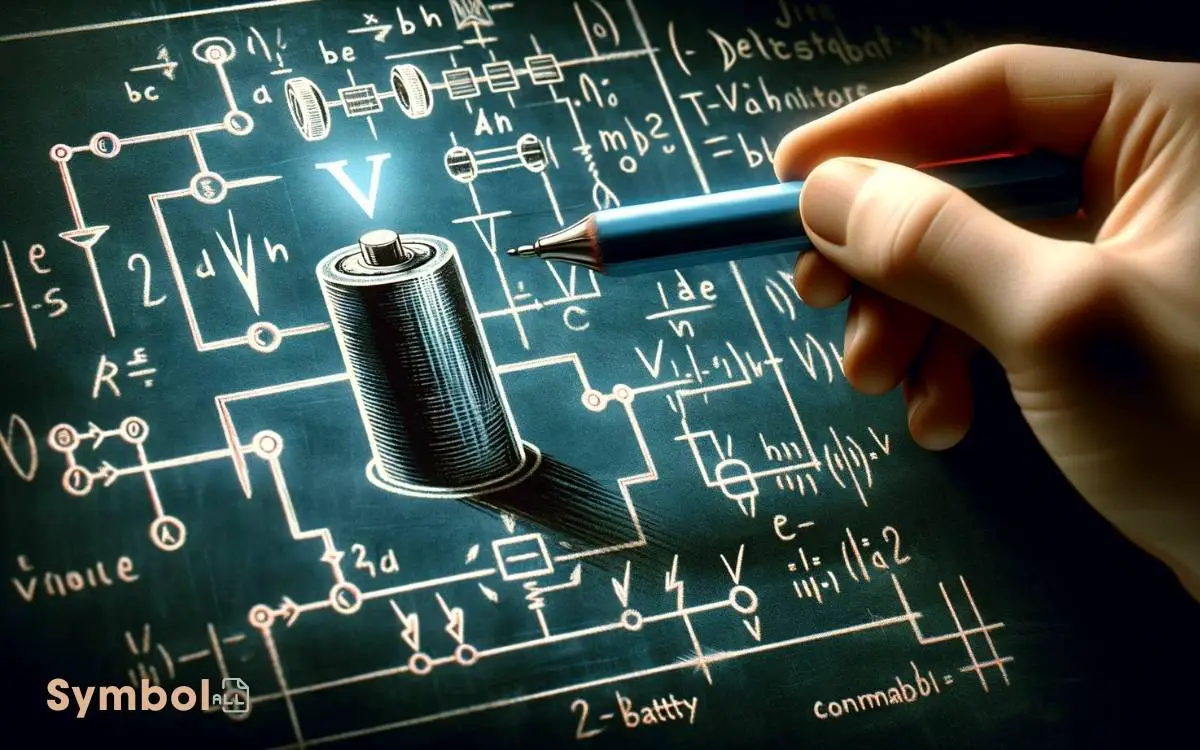What Is the Symbol for Voltage Used in Calculations? ‘V’!
In your electrical calculations, you’ll often use ‘V’ as the symbol for voltage. This notation signifies the electrical potential difference between two points in a circuit.
It’s essential to grasp that ‘V’ quantifies the force that propels electrons through a conductor, driving the electric current. Recognizing how ‘V’ plays into Ohm’s Law and power calculations is vital for analyzing and designing electrical systems effectively.
‘V’ traces its origins to Alessandro Volta, reflecting the foundational role of voltage in electrical engineering.
Mastering its application ensures you can accurately predict system performances and optimize designs. Grasping this symbol opens doors to deeper insights into electrical concepts.

Key Takeaways
Understanding Voltage Basics
Voltage, often symbolized as ‘V,’ represents the electrical potential difference between two points and fundamentally drives the flow of electric current in a circuit.
When you’re engaging with electrical systems, grasping the concept of voltage is crucial. It’s the force that propels electrons through a conductor and is essential for the functioning of any electrical device.
Think of it like water pressure in a pipe; just as higher water pressure drives water to flow, a higher voltage drives a stronger current. It’s measured in volts, and understanding its role is vital for analyzing and designing electrical circuits.
Voltage can be generated through various means, including chemical reactions in batteries, electromagnetic induction, or photovoltaic cells, each method influencing the circuit’s design and functionality.
The Symbol for Voltage
In electrical engineering and physics, ‘V’ commonly denotes the symbol for voltage, a critical parameter in circuit analysis and design.
When you encounter ‘V’ in equations or schematics, it specifically refers to the electric potential difference between two points, which effectively drives current through a circuit.
This distinction is fundamental, as it underpins the behavior of circuit components, influencing how they manage or convert energy.
Understanding ‘V’ in this context allows you to accurately predict and analyze the performance of electrical systems.
It’s essential in the realm of circuit design, enabling you to apply Ohm’s Law, calculate power consumption, and much more. Grasping the significance of ‘V’ paves the way for mastering complex electrical engineering concepts.
Historical Background of the Symbol
The symbol ‘V’ for voltage, with its roots deeply embedded in the history of electricity, stems from the Latin word ‘voltum,’ named after Alessandro Volta, a pioneer in the study of electricity.
Volta’s groundbreaking work in the late 18th and early 19th centuries laid the foundation for the modern understanding of electric potential and electromotive force.
The adoption of ‘V’ as the symbol for voltage honors his contributions and provides a universal shorthand for this critical electrical parameter.
This choice reflects not just a nod to history, but also an adherence to a tradition of naming scientific units and symbols after key figures in their discovery and understanding.
Volta’s experiments, which led to the invention of the voltaic pile, the precursor to the electric battery, marked a significant leap in the harnessing and comprehension of electricity, solidifying his legacy within the scientific community.
Significance of the Voltage Symbol
Understanding the significance of the ‘V’ symbol in electrical calculations, you’ll grasp a fundamental aspect of electrical engineering and physics that’s essential for accurate analysis and design.
The ‘V’ symbol represents voltage, a core concept defining the electrical potential difference between two points in an electrical field. By convention, it quantifies the force that drives electric current through a circuit.
Recognizing ‘V’ in equations and schematics allows you to comprehend the operational parameters of electrical systems accurately. This understanding is crucial when calculating energy transfer rates in circuits, optimizing electrical efficiency, or diagnosing system failures.
Mastery of the ‘V’ symbol’s application ensures precise communication among professionals, facilitating the development and maintenance of reliable, efficient electrical systems.
Common Misconceptions
You might often encounter confusion regarding the voltage symbol, leading to incorrect applications in your calculations. Analyzing common examples of misuse can highlight the disparities between assumed and accurate representations.
This understanding is crucial for rectifying errors and ensuring precision in your electrical engineering tasks.
Voltage Symbol Confusion
Many learners mistakenly interchange the symbols for voltage, often confusing V (volt) with other electrical units in their calculations. This confusion stems from a lack of understanding of the fundamental principles underlying electrical measurements.
Voltage, represented by the letter V, is a measure of the electric potential difference between two points. It’s crucial to distinguish it from current (I), which measures the flow of electric charge, and resistance (R), which quantifies the opposition to the flow of current.
Misinterpreting these symbols not only leads to incorrect calculations but also hampers the ability to accurately analyze and solve electrical circuits. Ensuring clarity in the use of symbols is imperative for precision in electrical engineering and physics. Moreover, a lack of standardization or consistency in symbol usage can create confusion, especially when collaborating across teams or disciplines. For instance, understanding how specific notations, such as the division symbol in JavaScript code, are applied is essential for avoiding errors in programming or simulation tools. Proper training and adherence to established conventions are thus critical for fostering effective communication and accurate problem-solving.
Incorrect Usage Examples
Let’s examine some typical errors in symbol usage that exacerbate confusion and lead to inaccuracies in electrical calculations.
A common mistake is using ‘V’ and ‘v’ interchangeably, assuming they represent the same concept. However, ‘V’ denotes voltage, a potential difference, while ‘v’ often signifies velocity in physics, leading to misinterpretation.
Another error lies in confusing ‘U’ with ‘V’. While some European countries use ‘U’ to denote voltage, globally, ‘V’ is the standard symbol in electrical calculations. Misusing these symbols can result in flawed analysis, especially in cross-border collaborations.
It’s crucial to adhere to the universally accepted ‘V’ for voltage to maintain clarity and precision in your work, ensuring your calculations are both accurate and universally understood.
Voltage Symbol in Circuit Diagrams
When you encounter circuit diagrams, understanding the symbols for voltage is crucial to interpreting the design accurately. You’ll find that common symbols, such as the letter ‘V’ or specific graphical representations, denote voltage in various contexts.
This section will guide you through the basics of voltage representation and how to decode these symbols in circuit diagrams effectively.
Voltage Representation Basics
In electrical schematics, the symbol ‘V’ typically represents voltage, a fundamental parameter indicating the electric potential difference between two points. Understanding this representation is crucial for anyone delving into the realm of electrical engineering or circuit design.
Here are three key aspects to keep in mind:
- Precision: The symbol ‘V’ isn’t just a placeholder; it’s a precise indicator of voltage within a circuit, guiding calculations and analyses.
- Context: Its application varies slightly depending on the context—whether you’re dealing with direct current (DC) or alternating current (AC) scenarios.
- Standardization: This symbol is standardized across schematics globally, ensuring consistency and facilitating international collaboration and understanding among engineers and technicians.
Grasping these basics empowers you to navigate more complex electrical concepts with confidence.
Common Symbols Explained
Delving into circuit diagrams, you’ll quickly recognize the voltage symbol ‘V’ as a critical component representing electric potential difference with precision and clarity.
This notation isn’t arbitrary; it’s grounded in scientific convention, facilitating universal comprehension among engineers and technicians.
The ‘V’ symbol, while simple, encapsulates a complex concept, embodying both the magnitude and direction of potential difference across two points in a circuit.
Its presence in diagrams isn’t merely symbolic but serves as a beacon, guiding the analyst in understanding the circuit’s functionality.
Moreover, the ‘V’ is often accompanied by subscript labels or numerical values specifying particular nodes or components, enhancing the diagram’s informational value.
This meticulous approach ensures that you, as a reader or practitioner, can interpret these diagrams with accuracy, bridging the gap between theoretical knowledge and practical application.
Interpreting Circuit Diagrams
Having grasped the significance of the voltage symbol ‘V’ in circuit diagrams, it’s vital to understand how to accurately interpret its application within these visual representations.
Here are three crucial aspects to keep in mind:
- Location Matters: The placement of ‘V’ alongside specific components indicates where voltage measurements should be taken or where voltage is applied. This precise positioning is essential for understanding the circuit’s functionality.
- Directional Indications: In some diagrams, arrows or polarity symbols accompany ‘V’ to show the direction of voltage flow, which is critical for components like diodes that require correct orientation.
- Reference Points: The ‘V’ symbol is often used with reference points or ground symbols to denote voltage differences, essential for calculating potential differences across components.
Practical Applications
Understanding the symbol for voltage, denoted as ‘V,’ is crucial when you’re applying it to real-world electrical and electronic calculations.
When you’re designing or troubleshooting circuits, knowing how to accurately calculate voltage drops across components ensures the system operates within safe and efficient parameters.
For instance, in a series circuit, the total voltage is the sum of voltages across each component. This principle is pivotal in determining the correct resistor values to use, thus preventing potential damage to sensitive components.
Similarly, in parallel circuits, understanding that voltage remains constant across all paths allows you to calculate current flow accurately.
This knowledge is indispensable in applications ranging from simple LED circuits to complex systems like power distribution networks, where precise voltage control is vital for stability and efficiency.
Learning and Remembering the Symbol
To effectively apply your knowledge of voltage in electrical circuits, it’s imperative you remember that ‘V’ symbolizes voltage in calculations. This singular character stands as the cornerstone in understanding and manipulating electrical properties.
Here are three strategies to reinforce this crucial symbol in your memory:
- Association: Link ‘V’ with ‘Voltage’ visually and conceptually. Imagine the ‘V’ as a potential difference driving current through a circuit.
- Repetition: Regularly use ‘V’ in calculations. Through continuous application, its association with voltage becomes second nature.
- Contextual Learning: Engage with problems that require the application of voltage. Solving real-world problems enhances retention by contextualizing the symbol within practical scenarios.
Conclusion
You’ve journeyed through the electrifying world of voltage, learning that the symbol ‘V’ represents this fundamental electrical parameter.
From its historical roots to its pivotal role in circuit diagrams, understanding the ‘V’ is crucial for any aspiring electrician or engineer.
Don’t let common misconceptions zap your confidence; remember, ‘V’ stands vigilant in the realm of electrical schematics. Embrace it as your talisman in the modern-day alchemy of electronics.
Now, armed with knowledge and precision, you’re charged to tackle practical applications with analytical prowess.





